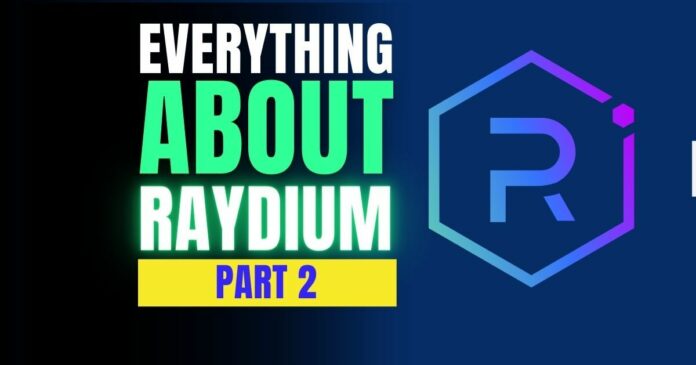Decentralized exchanges have become more popular since the FTX collapse. So, we’ve looked at a couple of DEXes and most recently talked about Raydium, a DEX built on the Solana blockchain. Here’s the link to the first part of our Raydium article series.
So, now, let’s go straight to this second part about Raydium.
What Is Raydium Farming?
We already noted that liquidity pools are a part of Raydium’s makeup. Farms on this DEX are simply liquidity pools on the platform. These pools enable liquidity providers (LPs) to earn RAY tokens on top of the trading fees from their liquidity pair.
AMMs automatically issue liquidity providers with LP tokens that represent their share of the pool when they deposit tokens into it. Through this approach, Raydium users can look into farming options that could boost their yield.
They can farm, lend, or borrow the RAY tokens and receive additional rewards. However, users must deposit the appropriate ratio of assets in a liquidity pool on Raydium to use this system.
LPs can also use their LP tokens to farm two tokens simultaneously on Raydium. They can deposit/lend them in a single pool. This is known as a fusion pool. It offers more ways to earn from farming on the platform.
Raydium is excited to announce that farming rewards will launch for @LidoFinance stSOL-SOL and stSOL-USDC concentrated liquidity pairs on December 6th at 16:00 UTC! 🧑🌾
🔗👇https://t.co/IjYCR4cPUp pic.twitter.com/HrnKdrANiS
— Raydium (@RaydiumProtocol) December 6, 2022
How Does Raydium Work?
While Raydium can match orders with far better algorithms and operations than other AMMs thanks to Solana’s high scalability, the platform appears to have struck a unique balance between decentralization and efficiency. The Solana-based DEX has two core features. It first gives users access to Serum’s order book. Then, its algorithm relies on a constant function, CFAMM (constant function automated market maker).
Any project team on #Solana can create a concentrated liquidity pool for any token pair on Raydium
W/ customized fees and farming emissions to boot! 💪
What’s even better is that the pair will be tradable on @JupiterExchange 🫡
Learn More 👇https://t.co/BRUJqEnRxl
— Raydium (@RaydiumProtocol) December 5, 2022
As earlier noted, the DEX provides on-chain liquidity to a central limit order book. So, users and liquidity pools can access the order flow and liquidity of the broader Serum ecosystem.
Anyone can provide liquidity to the supported pools by staking the assets listed in the pool. This is as opposed to using dedicated market makers. For instance, users would need to stake a precise preset ratio of SOL and USDC if they want to provide liquidity for an SOL/USDC pool.
Raydium uses the mathematical equation K = Y*X to provide customers with unlimited liquidity. This also removes inconsistencies, guaranteeing that the ratio of assets in liquidity pools is equal. In this case, K is constant while Y represents the value of Asset A, and X represents the value of Asset B.
This formula reportedly has a special anonymity feature that enables two tokens to coexist without disclosing information about their values and prices.
How to Convert Raydium to USD
You can use platforms like Coinbase and Kraken to convert Raydium to USD. As of this writing, the conversion value for one RAY is $0.186 USD.
Raydium NFTs
Magic Eden and Raydium collaborated to launch an NFT marketplace on Raydium. This way, the community gets exposed to a wide option of NFTs and liquidity. Magic Eden’s NFT collections are dual-listed on Magic Eden and Raydium.
Today, @RaydiumProtocol and #MagicEden are launching an NFT marketplace on https://t.co/6PVI6ih3Yv to give the community the best options, liquidity, and exposure. All Magic Eden collections will be dual-listed on ME + Raydium. LFG! More below 👇🏼
— Magic Eden 🪄 (@MagicEden) October 20, 2021
Raydium users can also trade NFTs natively on the website, powered by Magic Eden. Magic Eden is already one of the widely-used marketplaces on Solana. Magic Eden also integrates Raydium’s Swaps. This allows any token to serve as payment for NFTs on the platform.
Now that’s it for now. Don’t forget to read our first cover on this topic. And finally, let us know what you think about Raydium in the comments below.
⬆️For more cryptocurrency news, check out the Altcoin Buzz YouTube channel.
⬆️ Check out our most up-to-date research, NFT and Metaverse buy, and how to protect your portfolio in this market by checking out our Altcoin Buzz Access group. And for a limited time, it’s FREE. Just click the link and try it today.




























